The tolar was the currency of Slovenia from 8 October 1991 until the introduction of the euro on 1 January 2007. It was subdivided into 100 stotinov (cents). The ISO 4217 currency code for the Slovenian tolar was SIT. From October 1991 until June 1992, the acronym SLT was in use.

The Kuwaiti dinar is the currency of Kuwait. It is sub-divided into 1,000 fulūs.

The dinar is the name of the principal currency unit in several countries near the Mediterranean Sea, with a more widespread historical use. The English word "dinar" is the transliteration of the Arabic دينار (dīnār), which was borrowed via the Syriac dīnarā, itself from the Latin dēnārius.
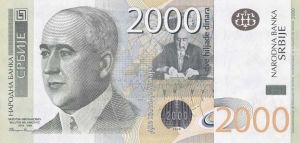
The dinar is the currency of Serbia. The dinar was first used in Serbia in medieval times, its earliest use dating back to 1214. The dinar was reintroduced as the official Serbian currency by Prince Mihailo Obrenović in the 1868. One dinar was formerly subdivided into 100 para.

The kuna was the currency of Croatia from 1994 until 2022. It was replaced by the euro in 2023. The kuna was subdivided into 100 lipa. It was issued by the Croatian National Bank and the coins were minted by the Croatian Mint.

The krone was the official currency of Austria-Hungary from 1892 until the dissolution of the empire in 1918. The subunit was one hundredth of the main unit, and was called a Heller in the Austrian and a fillér in the Hungarian part of the Empire.
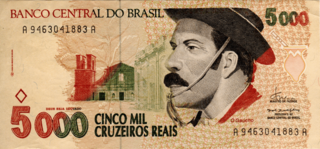
The cruzeiro real was the short-lived currency of Brazil between August 1, 1993, and June 30, 1994. It was subdivided in 100 centavos; however, this unit was used only for accounting purposes, and the coins and banknotes still valid for cruzeiro between 10 and 500 cruzeiros were used for the purpose of corresponding to the cents of that coin, especially when the redenomination was carried out. The currency had the ISO 4217 code BRR.

The East African shilling was the sterling unit of account in British-controlled areas of East Africa from 1921 until 1969. It was issued by the East African Currency Board. It is also the proposed name for a common currency that the East African Community plans to introduce.
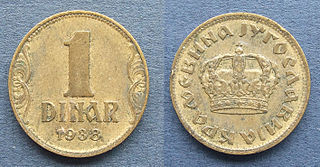
The dinar was the currency of Yugoslavia. It was introduced in 1920 in the Kingdom of Serbs, Croats and Slovenes, which was replaced by the Kingdom of Yugoslavia, and then the Socialist Federal Republic of Yugoslavia. The dinar was subdivided into 100 para.

The Krajina dinar was the currency of the Republic of Serbian Krajina between 1992 and 1994.

The hwan (Korean: 환) was the currency of South Korea between February 15, 1953, and June 9, 1962. It succeeded the first South Korean won and preceded the second South Korean won.
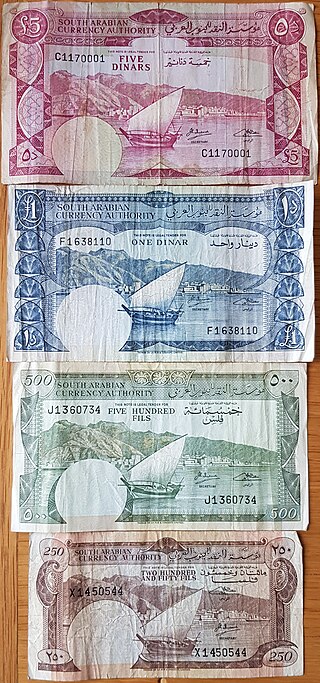
The dinar was the currency of South Arabia and then South Yemen between 1965 and 1990. It was subdivided into 1000 fils (فلس). After Yemen's monetary unification on 1 July 1990, it was one of the two official currencies used in Yemen Republic until 11 June 1996.
The Bosnia and Herzegovina dinar was the independent currency of Republic of Bosnia and Herzegovina between 1992 and 1998.

The Bohemian and Moravian koruna, known as the Protectorate crown, was the currency of the Protectorate of Bohemia and Moravia between 1939 and 1945. It was subdivided into 100 haléřů.

The franc was the currency of Tunisia between 1891 and 1958. It was divided into 100 centimes (صنتيم) and was equivalent to the French franc.
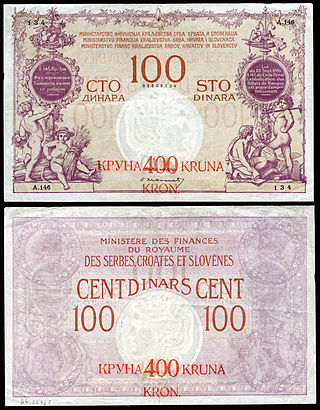
The krone was a short-lived, provisional currency used in parts of the then newly formed Kingdom of Serbs, Croats, and Slovenes, parts of which had previously been part of the Austro-Hungarian Empire (Austria-Hungary). It was worth 1⁄4 of a dinar or 25 para. The name translates into English as crown.

The đồng was the currency of North Vietnam from 3 November 1946 to 2 May 1978. It was subdivided into 10 hào, each itself divided into 10 xu.

The kuna was the currency of the Independent State of Croatia in the period between 1941 and 1945 during World War II. The word kuna means "marten" in Croatian and the same name is used for the modern Croatian kuna currency, which was later replaced with the euro. This kuna was subdivided into 100 banica. It was preceded and replaced by the Yugoslav dinar.
The banknotes of the Yugoslav dinar were several series of paper money printed by the central bank of the different consecutive states named Yugoslavia.
This is a description of the current and historical currencies of Croatia, or historically used in the region. The currency of Croatia is the euro, in use since 2023.















